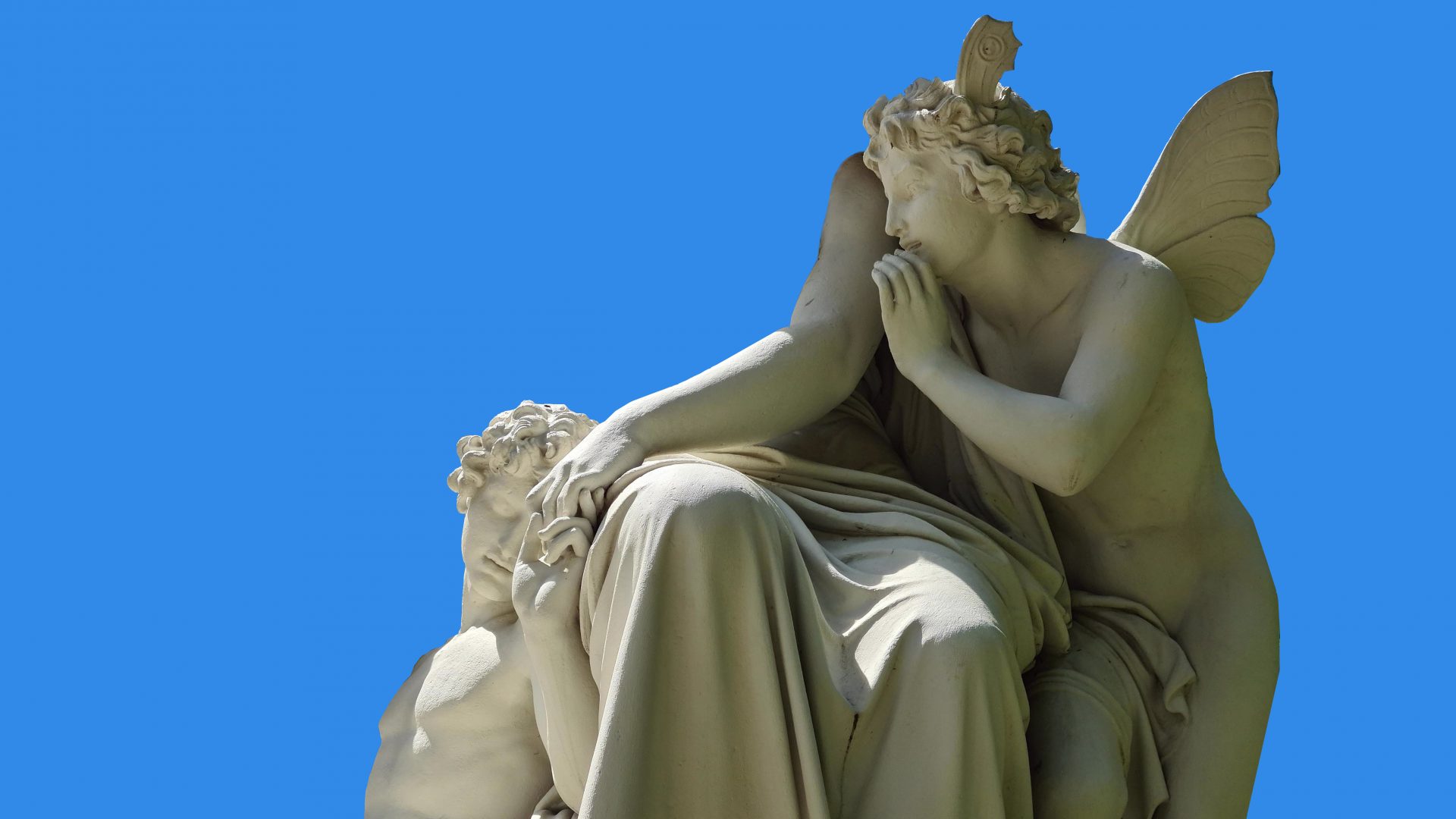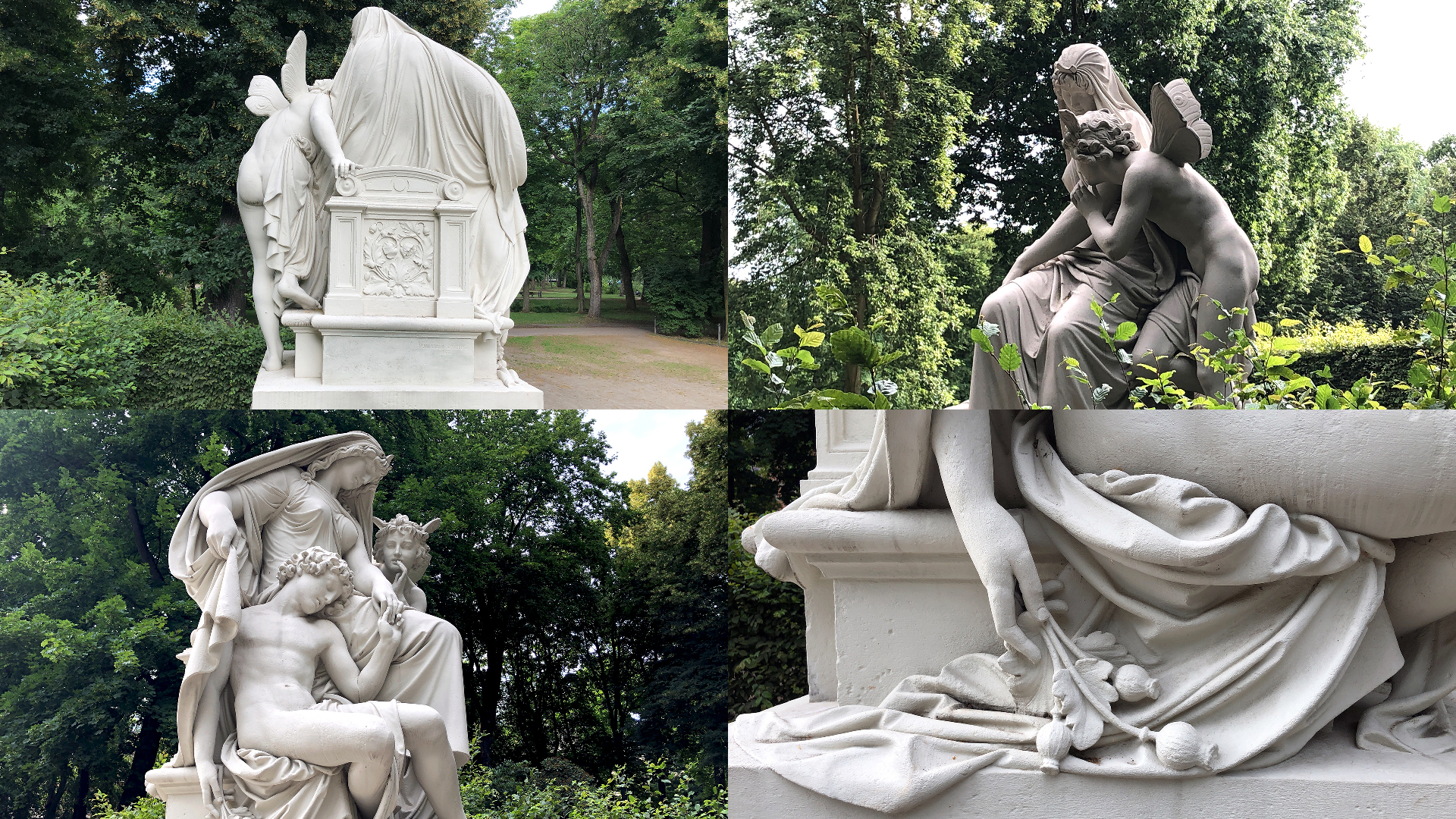
A crescent moon adorns the head of Nyx, “Night”, who gently spreads her cloak around the sleeping boy at her knees, while he lightly grasps the fingers of her left hand. Both heads tilt slightly to the left, to where a winged youth whispers into his cupped hand. Only to him, the sleeping boy, Morpheus murmurs. The dream messenger seems to have just arrived, for he has not yet shed his wings, nor are both – boy and messenger – fully in the land of dreams.
Just now the messenger of the dream seems to be making sure that the man has indeed fallen asleep. Does the arm of the goddess guide his soft speech to the ear of the boy like a whispering gallery? Will she release her hand from that of the sleeper as soon as the sleep is deep enough to allow the passage to the land of dreams?
Past the streams of Oceanus they went, past the rock Leucas, past the gates of the sun and the land of dreams, and quickly came to the mead of asphodel, where the spirits dwell, phantoms of men who have done with toils.
(Homer, Odyssey 24, 10-14)
Only there can humans receive the dream messages. They change from the material world to that of sleep in which the events of the dream, which are not perceived as an inner psychic process, but as experiences in another world, are real. Here interaction with the dream messenger is possible, action as well as speech. Once the message has been conveyed, comfort given and received, happiness felt, the messenger leaves the sleeping person.
After he has fulfilled his mission and left the land of dreams, he gathers his wings again and flies back to his cave. It is questionable, however, whether we can really speak of a shedding of the wings, whether his form, to which the wings necessarily belong, does not rather change as a whole. Or does the discarding of the wings stand for the leaving behind of one’s own and the rising into the assumed form? What then is his very own form? That of a winged demon who appears as an ideal youth as soon as he imagines himself in view? It is a bit like the question of what colour a chameleon is when it is in an environment where there is nothing to adapt to.
Night bore also hateful Destiny, and black Fate, and Death; she bore Sleep likewise, she bore the tribe of dreams; these did the goddess, gloomy Night bear after union with none. Next again Blame [Mōmos], and Care full-of-woes
(Hesiod, Theogony 210-215)
The fatherless brothers are dream gods, they act as mediators between humans and gods. Their messages are mostly for rulers and kings, but are often deceptive. Once Apollo asked Zeus for the gift of infallible prophecy, which, once received, made him so arrogant that Zeus, in order to stop him, created the truth dreams. Now, without having to appeal to Apollo, people could see the future in their dreams on their own authority. Apollo, deprived of his power, begged Zeus not to allow prophecy to be entirely replaced by truth dreams. Zeus, who accepted Apollo’s apology, now sent false dreams to the people, who then turned to Apollo again.
For two are the gates of shadowy dreams, and one is fashioned of horn and one of ivory. Those dreams that pass through the gate of sawn ivory deceive men, bringing words that find no fulfillment. But those that come forth through the gate of polished horn bring true issues to pass, when any mortal sees them.
(Odyssey 19, 562–568)

In the extended Chemnitz Castle Ponds Area, the “Four Times of Day” figure groups are based on the award-winning designs of Johannes Schilling. The German-Bohemian sculptor executed the sculptures. The sandstone sculptures, originally intended for the Brühl Terrace in Dresden, were donated to the city of Chemnitz in 1898 and changed their location there several times until they found their final place in front of the fountain in Chemnitz’s Schlossteichpark in 1936. They are all in a deplorable condition: their subsequent gilding, which provoked much opposition, has chipped off in many places and does not fulfil its purpose as protection against weathering in any way. Black stains mar the surfaces and distort the facial expressions of the figures. After two restorations in 2010/11 and 2017, they now wear a layer of silicone resin that not only protects the figures but also imitates the original sandstone surface.
Marlen Wagner